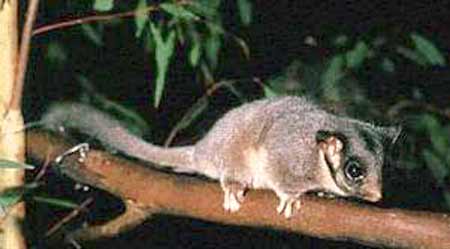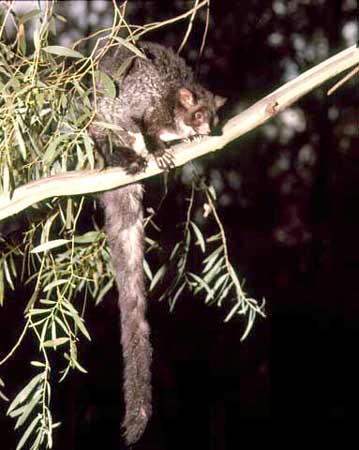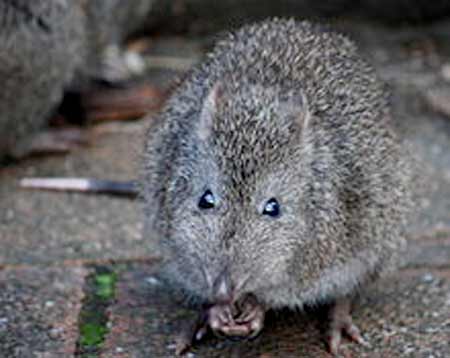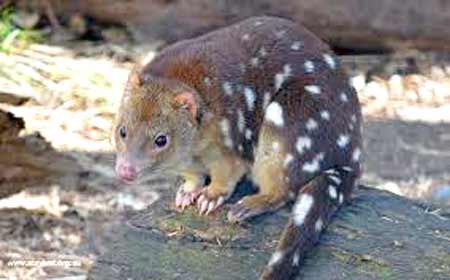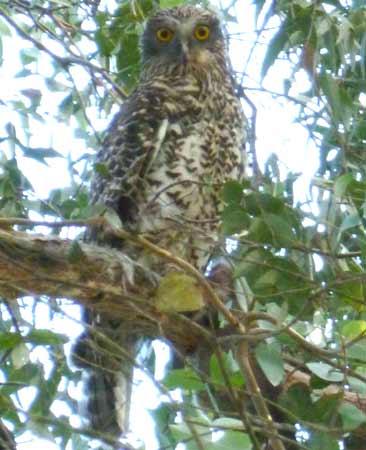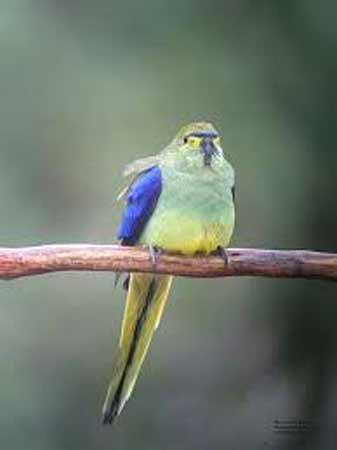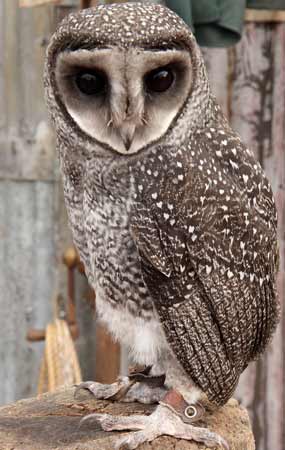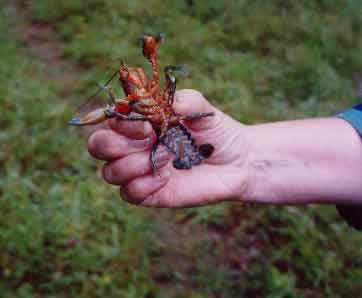Hancock Watch Home
Fauna
Leadbeaters Possums's (Gymnobelideus leadbeateri) were sited on the southern side of Mt Fatigue in the 1940's. They had been thought to be extinct since 1907. A population was discovered in the Central Highlands in 1961 and remains periously close to extinction.
Greater Glider (Petauroides volans) require
reserves of at least 6000ha to ensure survival. Image Source: Biodiversity
Snapshots. Greater Gliders are totally dependent on hollow-bearing
trees in which to den during the day and raise their young. Greater
Gliders usually require a variety of eucalypts. They feed almost exclusively
on the leaves, buds and floweres of eucalypts. Greater Gliders usually
die if all or most of their home range is intensively logged or cleared.
Unless they are linked as part of an interconnecting network of reserves,
local populations risk extinction through catastrophe or inbreeding.
Potoroo (Potorous tridactlys) was known to exist in low numbers in Tarra and Bulga National Parks in the 1970's. When was the last time a potoroo was observed in the Strzeleckis?
Numbers of Yellow Bellied Gliders (Petaurus australis) in the Macks Creek/Bulga National Park were by the 1970's very low. Chewballs and sightings occurred in nearby College Creek in the late 1990's.
Tiger Quolls have been recently recorded at Middle Creek in 2011 and Dingo Creek region in the late 1990's.
The powerful owl is classified as rare. It is also listed under schedule 2 Flora and Fauna Guarantee Act 1988. The powerful owl is totally dependent on hollow bearing trees. The powerful owl has been recorded in the area and was taped in College Creek in 1998. In light of the significance of Strzelecki Fauna this important letter dated 26 November 1979, highlighted the significance of the Macks Creek region - a large portion of which has now been converted to pine plantations. BADRA Balook and District Residents'Association Date: 26th November 1979. The Hon. F.J. Granter, Minister of Forests, Office of The Minister of Forests, 601 Bourke Street, Melbourne 3000. Dear Mr Granter, RE: MACK'S CREEK VALLEY BALOOK: We refer to our telegram to you of November 7th., our follow up letter of November, 12th., and our letter of 16th. November covering our preliminary submission on our Association's objections to the logging operations proposed to be carried out in the above area. Set out below is our final submission. Discussion and Individual Species: Three major factors must be considered the heart of our objections. Firstly, the inadeqaute sizes of the two local National Parks*, Tarra Valley (140 ha) and in this case more importantly Bulga (80 ha) making a total of 220 ha. of permanently protected forest in the Eastern Strzelecki Ranges. This has been noted by a number of prominent authors including J. Ros Garnet who in 1960 commented on the parks ëach is much too small to serve the real purpose of a National Park". In 1969, Morcombe remarked that "the quality of their lush vegetation (may be) ruined by land clearing and settlement about their borders." At the present time, with theories of island biogeography well known (Diamond 1975) (Keast 1976), it is clearly apparent that the two parks are in grave danger of becoming isolated from areas of natural forest from which restocking of the diverse faunal and floristic associations and communities recorded from the parks may continue to take place (Beauglehole 1972) (Walker 1979). A further relevant note concerning area is provided by Tyndale-Biscoe and Calaly (1975) who have shown that a reserve of at least 6,000 ha. be the minimum size to ensure the survival of the Greater Glider (S. Volans) in a forested area. Similar figures are available for other species of mammals and accordingly the role played by the two National Parks in directly conserving large mammal species is insignificant. * (Tarra Bulga has now increased in size to 2015 ha Ed.): Following recommendations by the Land Conservation Council, the two separate National Parks were joined through a land exchange with A.P.M. Forests Pty Ltd. An enlarged and renamed Tarra-Bulga Park of 1,230 hectares was declared in June 1986. By 1990 Tarra-Bulga National Park covered 1,625 hectares of some of the best examples of original forests of the Strzelecki Ranges. Additions in 2005 increased the park size to 2,015 hectares. It is our contention therefore that, until the Land Conservation Council of Victoria issue their final recommendations with regard to the area in question, it be retained in its present condition so continuing to act as a substantial buffer zone on the southern boundaries of Bulga National Park. The second point which must be raised is that of eucalypt diversity, records listing only one species of eucalypt for Bulga National Park, that being Mountain Ash (Eucalyptus Regnans), whereas the Mack's Creek valley contains substantial stands of Mountain Grey Gum (E. cypellocarpa) and Messmate (E. obliqua) and this diversity, coupled with the large extant natural corridors, permit the continued existence of leaf-feeding mammals such as Koala (P. cinereus) and Greater Glider (S. Volans), both species being unable to subsist on a diet of E. regnans alone. The third objection put forward by BADRA is that any replanting program is necessarily accompanied by the use of 1080 poison (Sodium fluoracetate) which is known to prove fatal to native animals including Possums (T. vulpecula and T. caninus), and also the Swamp Wallaby (w.bicolor). With these factors in mind, it must be stressed that the effects of 1080 on other rarer native mammals, e.g Potoroo (P.tridactylus), the Yellow Bellied Glider (P. australis), are completely unknown and, as the two abovementioned mammals are known to occur within the proposed area of logging and replanting, the use of poison bait is both reckless and irresponsible unless the guidelines for the use of 1080 be employed as set out by The Keith Turnbull Research Institute June 1979. We shall now outline in more detail our concerns regarding individual species. Mammals Potoroo (P. tridactylus) The Potoroo is a small macropod whose biology is little known; however, at the time of writing, less than ten localities in Victoria are known where this species occurs and a number of these are in coastal heathlands with a correspondingly higher risk of fire severely depleting populations than us present in the wet sclerophyll forests of the S.E Strzeleckis. The potoroo occurs in low numbers in both Tarra Valley and Bulga National Parks, and we beleive that the pressures brought about by local land clearance and subsequent logging operations will adversely affect the potoroo in a number of ways. Firstly, destruction of cover: the animal requires runways beneath the understorey vegetation and obviously bulldozing activities will severely inhibit this practice. Secondly, opening up areas will allow rabbit introduction deeper into the valley and create a further unnatural competitive pressure for food resources. Thirdly, the rabbit increase will allow an increase in numbers of introduced predators such as cats and foxes, who unquestionably have adversely affected p. tridactylus in recent times throughout Eastern Australia. Yellow Bellied Glider (P. australis) P. australis is the largest member of its genus and unquestionably the rarest, occurring only in odd pockets of the State and very rarely south of the Princes Highway. The species requires overmature eucalypts for shelter and is known to die if its nest tree is removed. Common feeding sources are known to include Blackwood (Acacia melanoxylon) (pers. obs.), E. cypellocarpa, E. obliqua (Fleay, pers. obs.), all amongst the proposed trees for removal from Macks Creek Valley. P. australis is known to be highly nomadic (A. Smith pers. comm.), covering considerable distances in a single night in search of suitable food trees. Mountain Grey Gum is an autumn flowering species thereby providing essential nectar and insect food at a time when other food sources are minimal. As the numbers of P.australis in the Macks's Creek valley/Bulga National Park are very low and possibly the last remaining colony in the entire Strzelecki Ranges, we believe its only chance of survival rests with the Forests Commission Victoria to decide against further logging in the Mack's Creek Valley, particularly removal of E. cypellocarpa. The cropping of a nest tree and resultant death of the animal or animals inhabiting these trees must be considered a strong possibility and, coupled with the removal of other suitable food trees (in some cases spp. not represented in Bulga National Park e.g. Messmate (E. obliqua), logging would be clearly disastrous for this species. It is our firm belief that no action short of complete cessation of logging can provide P.australis with an opportunity for continued long term survival in South Gippsland. Statement: We believe that the Forests Commission Victoria by its intended actions unknowingly threatens the local survival of a number of native mammals including two species considered endangered throughout their ranges. We also believe that the Commission have acted fairly and responsibly in permitting us time to prepare submissions. It is now our earnest hope that fair play, responsibility and a genuine concern for the depleted mammal fauna of Victoria, and in particular of Victorian National Parks, will come into force and ensure the area in question be preserved with its full complement of faunal diversity. Birds A total of 75 species have thus been recorded from the forested areas of the Mack's Creek Valley, excluding records from land controlled by A.P.M. and the National Parks Service of Victoria. Of these, six species warrant further consideration on the grounds that they are considered uncommon to rare throughout Victoria (Wheeler 1967). The six are: (1) King Parrot (Alisteris scapularis) (2) Blue Winged Parrot (Neophema chrysostoma) (3) Brush Cuckoo (Cuculus variolosus) (4) Wonga Pigeon (Leusocarcia melanoleuca) (5) Red-Browed Tree Creeper (Climacteris erythrops) (6) Lewin's Honeyeater (Meliphaga lewinii) Our detailed objections to logging in regard to these species are as follows: (1) King Parrot:- The King Parrot was once widely distributed throughout the Strzelecki Ranges (Land of the Lyrebird 1922/24); but, due presumably to forest clearing activities and perhaps other unknown facts, e.g. disease, has declined rapidly in the past few decades to the present where their occurrence is limited to the Mt. Fatigue/Gunyah area and the Mack's Creek Valley where their status is unknown. Important factors in their survival include retention of overmature trees for the provision of nesting hollows and suitable food trees such as Blackwood (Acacia melanoxylon) (Forshaw 1969) and Native Cherry (Exocarpus cupriformis) (pers. obs.). This species has not thus far been recorded in Bulga National Park, and only one recent record exists for Tarra Valley National Park and must therefore be regarded as extremely rare in the Strzelecki Ranges. (2) Blue-Winged Parrot:- The Blue-Winged Parrot is regarded as moderately common in Victoria (Wheeler 1967) and is widespread throughout the state. The situation in the Strzelecki Ranges, however, is that scattered pairs of birds arrive in the ranges about mid-November each year, breed and depart in February (pers. obs.). This species also requires nesting hollows provided by overmature trees and feeds on a wide range of seeding native grasses. Although Wheeler considered the species moderately common in 1967, current opinion (1) Paton pers. comm.) believes that competition with the introduced Starling (Sturnus Vulgaris) for nesting hollows has contributed considerably to a substantial decline in the numbers of N. chrysostoma. Opening up of closed forest areas permits invasion by Starlings, and this competition would prove deleterious to population numbers of the declining Blue-Winged Parrot.
Blue Winged Parrot. Last observed by Hancock Watch December 2012 Flynns Creek. (3) Brush Cuckoo:- Wheeler regards the Brush Cuckoo as rather rare in Victoria, and personal observation throughout the State indicates this to be so. Cuculus variolosus is a baird inhabiting wet forest gullies in the southern section of its range. It presumably competes with the more abundant Fantailed Cuckoo (Cuculus pyrrophanus), the latter species being favoured more by open country. Although it may be argued that no logging of gullies will occur, the clearing activities will certainly provide increased habitat for Fantailed Cuckoos and, their greater numbers combined with factors such as increased sunlight modifying vegetation structure of the gullies, could prove locally disastrour for C. variolosus. (4) Wonga Pigeon:- The Wonga Pigeon is now an extremely rare bird within the Strzelecki Ranges, and nowhere throughout its range is it considered common. Formerly (Land of the Lyrebird) the Wonga Pigeon was widespread throughout South Gippsland and its decline may be directly related to forest clearing activities and the ravages of introduced predators, e.g. Cat (Felis catus), Fox (Vulpes Vulpes). The seed of Native Cherry (Exocarpus sp.) provides an important food source for this species (pers. obs.) and R. Loyn (pers. obs.), and the Mack's Creek Valley contains the most substantial stand of this tree in South Gippsland. The Wonga Pigeon occurs in very low numbers within the Macks Creek Valley, and further habitat disturbance in the form of logging and clearing so-called areas of scrub which provide necessary shelter and nesting sites would almost certainly eliminate the species from the region. The bird has been sporadically recorded from Bulga National Park.
Wonga Pigeon (5) Red-Browed Treecreeper:- The Red-Browed Treecreeper is regarded as rather rare within its limited range which closely approaches its south-westerly extremity in the Strzelecki Ranges (Wheeler 1967). The species forages on the bark of trees, preferring rough barked species such as Messmate (E. obliqua) (Noske 1979). Throughout its range, it is associated with wet forest gullies and appears to have a low tolerance to habitat modification (pers. obs.). This species is another requiring overmature trees to provide nesting hollows, and similar comments regarding Starlings (S. vulgaris) and Blue-Winged Parrots (N. chrysostoma) would apply here. The species has been infrequently recorded from both Tarra Valley and Bulga National Parks. Its status in the Mack's Creek Valley is uncertain but it can be stated that it is not common. (6) Lewin Honeyeater:- M. Lewinii is unquestionably the rarest honeyeater resident in Southern Victoria (Wheeler 1967). The species is strongly territorial and an area of approximately 5ha (pers.obs.) is required by a single pair, and this area must incorporate considerable gully vegetation and water as the species nests in dark gullies near permanent water. The Lewin Honeyeater is a wet sclerophyll forest specialist, rarely being observed outside this habitat; but with land clearance and other modifying activities, less specialised honeyeaters, e.g. New Holland Honeyeater (Phylidonyris novaehollandiae) are able to invade the territories of M. lewinii and displace the resident species, presumably utilizing aggressive feeding techniques, less area requirements and the ability to breed faster and more efficiently. The Mack's Creek Valley and Bulga National Park remain strongholds of this rare bird but, because of the large areas involved in territory requirements, any activities which favour competing honeyeaters represents a substantial hurdle for M. lewinii to overcome. Comments relating to the nesting of Brush Cuckoos apply equally to M. lewinii. Summary: In summary, of the 75 species thus far recorded from the Mack's Creek Valley, six species known to occur (of which three are believed resident, two (N.chrysostoma and C. variolosus) are migratory and the remaining species A. scapularis is of unknown residential status) are considered uncommon/rare by ornithological authorities, and all would be adversely affected by the proposed logging program in various ways as set out above. It must be stressed that other rare species may yet await discovery in the Mack's Creek Valley, including the extremely rare Sooty Owl which is known to occur in Tarra Valley and Bulga National Parks, and has recently been found breeding at Tarra Valley, such breeding appearing to represent the first recording for the State, and if the Mack's Creek Valley is untenanted by Sooty Owls the area would represent a potential dispersal site for the current one surviving juvenile.
Sooty Owls have been recorded at Tarra Bulga National Park Other rare Victorian species recorded from Bulga and Tarra Valley National Parks which may inhabit the Mack's Creek Valley include:- Beautiful Firetail (Embella bella) Black-faced Monarch (Monarchia melanopsis) Cicada Bird (Coracina tenuirostris) Grey Goshawk (Accipiter novaehollandiae) The available evidence regarding avian dispersal through corridors of natural bushland indicated the areas required by mammals are equally applicable to birds, particularly those species with high dispersal rates (Saunders 1977) and many others dependent on retention of naturally occurring ecotones. All the species discussed above fit either of these categories and we contend that the proposed logging will totally preclude their continued natural presence in the South Eastern Strzelecki Ranges.... Reptiles and Amphibians A total of eight skinks, two snakes and eleven frogs have been thus far recorded from the Mack's Creek Valley, all species having been recorded from one or both of the National Parks in the vicinity. The rare skink Pseudomoia spenceri occurs sparingly on the trunks of overmature E.regnans within the area is considered to be dependent on overmature and dead specimens of this tree (Rawlinson pers.comm) The effects of logging these habitat trees would be to seriously deplete the small remnant population of this rare species which is unable to survive without overmature E.regnans. The Mack's Creek Valley would appear to be an optimum environment for the rare Hylid, hitoria maculata (Corben pers.comm), and further research may reveal the presence of this species. Subtle changes to the microclimate of the creek such as increased turbidity known to be an indirect effect of logging (Rawlinson pers.comm) may adversely affect this rare species. A further Hylid, hitoria leseurii, uncommon in South Gippsland, occurs within the stream, and the above comments must equally apply to this species of restricted range... More InformationMountain Bobuck also require old trees for nest hollows. Their conservation is utterly dependent on sympathetic forest management which retains buffer strips of old forest between coupes and preserves old habitat trees and their potential successors in small unlogged areas. The Common Brushtail Possum tends to replace the Bobuck possums in areas disturbed by logging. English's Corner was selected as a site of local and scientific interest by Mansergh and Norris in 1982 because it is one of only two localities south of the Princes Highway where the Broad-toothed rat is recorded. It is an uncommon animal, usually found in the alpine and subalpine heathlands and open eucalypt woodlands of the Snowy Mountains and Victorian Alps, in clearings with dense undergrowth in the wet sclerophyll forests of the Dandenong and Otway ranges, and in wet sedgelands and subalpine heathlands in Tasmania. This species was recorded near English's Corner in predator scats in 1996. Superb Lyrebird The Superb Lyrebird is a common in the area, particularly within and adjacent to rainforest. The Lyrebird courtship display takes place on or near mounds. These mounds can be commonly seen and the territorial song of the male is frequently heard. The main predators are cats, dogs and foxes, and these pose a risk to the survival of the species. Other birds The report by Mansergh and Norris, 1982, reported 37 species of birds in this area. Many of these birds are dependent on nectar and blossom from the older trees. Young trees are very poor providers of blossom and nectar. If too many of the older trees are removed to extend plantations, and plantations have a short rotation time of 25 to 30 years, this will drastically reduce the availability of nectar and blossoms for these birds.
Endangered Freshwater Crayfish The distribution of Engaeus rostrogaleatus in south Gippsland, Victoria. At present there is little information on the effects of disturbances such as timber harvesting on the long term population levels. Several studies have shown that forestry activities can be deleterious to stream biota by increasing siltation, turbidity, salinity and stream habitat integrity (see review by Campbell & Doeg 1989, Growns & Davis 1994). Buffer zones are an established method used extensively in forestry management to protect streams. Davies & Nelson (1994) investigated the effectiveness of buffer zones on stream fauna and determined that the impacts of logging are directly dependent on buffer widths. The authors found that a minimum buffer width of 30m was required to reduce logging impacts on streams and that buffer zones of between 30-100m appear to provide protection from short term logging impacts. Similarly, Barton &Davies (1993) found 30m buffer strips were effective in reducing the effects of pesticide concentrations in streams within plantations of Eucalyptus nitens in Tasmania. Larger buffer widths of 100m have been shown to reduce changes in stream fauna at least 8 years after logging ceased (Gowans & Davis 1991).
The rare Strzelecki Burrowing Crayfish found in a logging coupe: Recent research into the effects of herbicides on native Australian crustaceans is of concern. Recent research by the RMIT University has revealed that the acute toxicity of Roundup to two week old C.destructor (freshwater crayfish - Australian Yabby), ranged between 0.4 and 8 mg glyphosate/l (120 hour LC50) with interbrood variability. The recommended agricultural application rate for Roundup which is 5-7ml/l at the rate of 2-3 l/ha (Monsanto, 1986) may therefore pose an ecological risk to Australian freshwater crustaceans. Australian native freshwater crustaceans are more sensitive to this herbicide than similar Northern Hemisphere species. (see Environmental Engineering Society Website). Plantation companies such as Hancock regularly spray with a cocktail of herbicides including Roundup. What is the effect of plantation herbcides on species of Crayfish in the Strzeleckis? While these studies relate specifically to the instream fauna, the effects of timber harvesting on the fauna which inhabit stream margins remains largely unknown. Horwitz (1990b) suggests that forestry activities may pose direct and indirect threats to the crayfish through habitat destruction from creation or use of logging roads and removal of vegetation. Any activity leading to an alteration in the nature of the streamside water table or drainage patterns could affect the species survival. Variation in stream flows and water table levels occur when forest vegetation is cleared and when regrowth forest is planted. This is due to decreased transpiration rates after tree felling followed by increased transpiration rates in regrowth. Any activity which damages stream bank intergrity and alters water tables and drainage lines could be potentially harmful. Doran & Richards (1996) investigated the management requirements of the Mt Arthur burrowing crayfish, Engaeus orramakuna, found in north-east Tasmania. They examined populations in logged and unlogged areas and found the species to be in high abundance in logged areas with healthy, fertile populations present throughout sites where E. phyllocercus was collected. In the current survey, these species were never found to be sympatric with E. phyllocercus, although their ranges obviously overlap. Therefore it is possible the species may occur if wet forest is located within the region or that the presence of E. quadrimanicus/cunicularius excludes E. phllocercus in this part of the species range. Mt Worth, an area of 1040ha, is the only State Park from which the species is located. The number of specimens of E. phyllocercus collected from Mt Worth was low, but this was most likely a result of sampling difficulties rather than a true reflection of crayfish distribution. The crayfish is probably wide spread throughout the flood-beds of streams in the park, particularly those dominated by Mountain Ash and closed fern communities. It is evident from some of the locations from which the crayfish were collected, that they can tolerate some level of disturbance. However, it is uncertain as to whether crayfish occur at the same density at these sites or whether their long term survival is secure. The Strzelecki burrowing crayfish does not appear to occur extensively outside the 30km2 range estimated by Horwitz (1990). However, like the Narracan crayfish, it is widespread througout its range occurring in flood beds and creek banks of streams, particularly the smaller stream tributaries. It is also common in very wet gullies and seepage areas with underground springs. Much of the land within the species range appears to be occupied by suitable habitat, although its distribution within pine plantations needs clarification. Most sites from which E. rostrogaleatus was collected occur within land utilized for softwood and hardwood plantation owned by Hancocks and Australian Paper Plantations. The 1230ha within Tarra-Bulga National Park represents the only area of protected habitat within the species range. E. rostrogaleatus most likely found in the following Hancock plantations; LEGL/93-78
|
